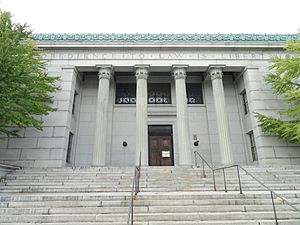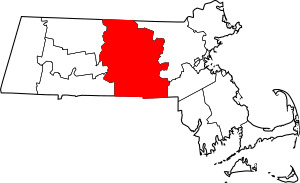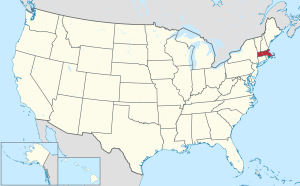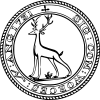Worcester County, Massachusetts facts for kids
Quick facts for kids
Worcester County
|
||
|---|---|---|

Worcester County Courthouse
|
||
|
||

Location within the U.S. state of Massachusetts
|
||
 Massachusetts's location within the U.S. |
||
| Country | ||
| State | ||
| Founded | April 2, 1731 | |
| Named for | Worcester, Massachusetts | |
| Seat | Worcester | |
| Largest city | Worcester | |
| Area | ||
| • Total | 1,579 sq mi (4,090 km2) | |
| • Land | 1,511 sq mi (3,910 km2) | |
| • Water | 68 sq mi (180 km2) | |
| Population
(2020)
|
||
| • Total | 862,111 |
|
| • Density | 570.7/sq mi (220.3/km2) | |
| Time zone | UTC−5 (Eastern) | |
| • Summer (DST) | UTC−4 (EDT) | |
| Congressional districts | 1st, 2nd, 3rd, 4th | |
Worcester County (pronounced WOO-stər) is a county in the state of Massachusetts. A county is like a large region or area within a state. In 2020, about 862,111 people lived here. This makes it the second most populated county in Massachusetts. It is also the largest county in the state by geographic size. The biggest city and main town, called the shire town, is Worcester. Worcester County is part of a larger city area that includes parts of Connecticut. It is also connected to the bigger Boston-Worcester-Providence region.
Contents
History of Worcester County
Worcester County was created on April 2, 1731. It was formed from parts of older counties: Hampshire County, Middlesex County, and Suffolk County. When the county government started, the city of Worcester was chosen as its main town, known as the "shire town." It remained the only shire town until the county government was dissolved.
Because Worcester County is so large, people tried to split it into two smaller counties fifteen times over 140 years. However, these attempts were never successful. At first, Lancaster was suggested as the main town for a northern county. Later, Petersham and Fitchburg were also suggested. As a compromise, in 1884, the county's land records office was split into two. The northern part was placed in Fitchburg.
Geography and Natural Features
Worcester County covers a total area of about 1,579 square miles. Of this, 1,511 square miles is land, and 68 square miles (about 4.3%) is water.
It is the largest county in Massachusetts by land area. In fact, it is even bigger than the entire state of Rhode Island, including Rhode Island's ocean areas. Worcester County makes up the central part of Massachusetts. It stretches from the northern border to the southern border of the state. The exact geographic center of Massachusetts is located in Rutland, which is in Worcester County.
Worcester County is one of only two counties in Massachusetts that borders three different neighboring states. These states are New Hampshire, Connecticut, and Rhode Island. The other county that does this is Berkshire County. These two counties are also the only ones that touch both the northern and southern state lines.
Neighboring Counties
- Cheshire County, New Hampshire - north
- Hillsborough County, New Hampshire - north/northeast
- Middlesex County - east/northeast
- Norfolk County - east/southeast
- Providence County, Rhode Island - south/southeast
- Windham County, Connecticut - south
- Tolland County, Connecticut - south/southwest
- Hampden County - west/southwest
- Hampshire County - west
- Franklin County - west/northwest
Protected Natural Areas
Population and People
| Historical population | |||
|---|---|---|---|
| Census | Pop. | %± | |
| 1790 | 56,764 | — | |
| 1800 | 61,192 | 7.8% | |
| 1810 | 64,910 | 6.1% | |
| 1820 | 73,625 | 13.4% | |
| 1830 | 84,355 | 14.6% | |
| 1840 | 95,313 | 13.0% | |
| 1850 | 130,789 | 37.2% | |
| 1860 | 159,659 | 22.1% | |
| 1870 | 192,716 | 20.7% | |
| 1880 | 226,897 | 17.7% | |
| 1890 | 280,787 | 23.8% | |
| 1900 | 346,958 | 23.6% | |
| 1910 | 399,657 | 15.2% | |
| 1920 | 455,135 | 13.9% | |
| 1930 | 491,242 | 7.9% | |
| 1940 | 504,470 | 2.7% | |
| 1950 | 546,401 | 8.3% | |
| 1960 | 583,228 | 6.7% | |
| 1970 | 637,969 | 9.4% | |
| 1980 | 646,352 | 1.3% | |
| 1990 | 709,705 | 9.8% | |
| 2000 | 750,963 | 5.8% | |
| 2010 | 798,552 | 6.3% | |
| 2020 | 862,111 | 8.0% | |
| 2023 (est.) | 866,866 | 8.6% | |
| U.S. Decennial Census 1790-1960 1900-1990 1990-2000 2010 2020 |
|||
According to the 2020 census, 862,111 people lived in Worcester County.
2010 Census Information
In 2010, there were 798,552 people living in the county. There were 303,080 households and 202,602 families. The population density was about 528.6 people per square mile.
Most people in the county (85.6%) were white. Other groups included 4.2% Black or African American, 4.0% Asian, and 0.2% American Indian. About 9.4% of the population was of Hispanic or Latino origin. Many people had ancestors from Ireland (22.2%), Italy (14.4%), England (11.7%), and France (15.1%), including French Canadians (6.7%).
About one-third of households (33.7%) had children under 18 living with them. Half of the households (50.0%) were married couples. The average household had 2.55 people, and the average family had 3.09 people. The average age of people in the county was 39.2 years old.
The average income for a household was $64,152, and for a family, it was $79,121. About 9.5% of all people in the county lived below the poverty line. This included 12.1% of those under 18 and 9.0% of those aged 65 or older.
Cities and Towns
Worcester County is made up of many different communities. These include cities and towns, as well as smaller areas called census-designated places.
Cities in Worcester County
- Fitchburg
- Gardner
- Leominster
- Southbridge
- Worcester (the main county seat)
Towns in Worcester County
- Ashburnham
- Athol
- Auburn
- Barre
- Berlin
- Blackstone
- Bolton
- Boylston
- Brookfield
- Charlton
- Clinton
- Douglas
- Dudley
- East Brookfield
- Grafton
- Hardwick
- Harvard
- Holden
- Hopedale
- Hubbardston
- Lancaster
- Leicester
- Lunenburg
- Mendon
- Milford
- Millbury
- Millville
- New Braintree
- North Brookfield
- Northborough
- Northbridge
- Oakham
- Oxford
- Paxton
- Petersham
- Phillipston
- Princeton
- Royalston
- Rutland
- Shrewsbury
- Southborough
- Spencer
- Sterling
- Sturbridge
- Sutton
- Templeton
- Upton
- Uxbridge
- Warren
- Webster
- West Boylston
- West Brookfield
- Westborough
- Westminster
- Winchendon
Census-Designated Places
These are specific areas within towns that the U.S. Census Bureau defines for gathering statistics.
- Athol
- Baldwinville
- Barre
- Brookfield
- Clinton
- Cordaville
- Devens
- East Brookfield
- East Douglas
- Fiskdale
- Hopedale
- Lunenburg
- Milford
- North Brookfield
- Northborough
- Oxford
- Petersham
- Rutland
- South Ashburnham
- South Lancaster
- Spencer
- Sturbridge
- Upton
- Warren
- Webster
- West Brookfield
- West Warren
- Westborough
- Whitinsville
- Winchendon
Notable People from Worcester County
Many famous people have connections to Worcester County. Here are a few:
- Louisa May Alcott: A famous novelist who wrote Little Women.
- Johnny Appleseed: His real name was Jonathan Chapman, known for planting apple trees.
- Clara Barton: She founded the American Red Cross, which helps people in need.
- Luther Burbank: A skilled plant scientist who developed the russet potato.
- William Cullen Bryant: A well-known poet and journalist.
- George M. Cohan: A talented entertainer who wrote plays, songs, and acted.
- Robert Cormier: A novelist and newspaper writer.
- Ron Darling: A professional baseball pitcher who played in the World Series.
- Dorothea Dix: A social reformer who worked to improve conditions for people with mental illness.
- Fannie Farmer: A famous cookbook author.
- Abby Kelley Foster: A strong advocate for ending slavery and for women's rights.
- Robert H. Goddard: Often called the father of American rocketry.
- Elias Howe: He invented the sewing machine.
- Connie Mack: A baseball legend and long-time manager.
- Agnes Moorehead: A well-known actress.
- William T. G. Morton: He helped develop modern anesthesia for medicine.
- Joe Perry: A songwriter and guitarist for the famous band Aerosmith.
- Brian Skerry: An underwater photographer for National Geographic.
- Steve Spagnuolo: A successful football coach in the NFL.
- Lucy Stone: A famous leader in the women's suffrage movement, fighting for women's right to vote.
- Lydia Chapin Taft: The first woman in America to legally vote in a colonial election.
- Earl Tupper: The person who created Tupperware.
- Artemas Ward: A major general during the American Revolution.
- Eli Whitney: He invented the cotton gin, a machine that made cotton processing much faster.
- Scott Young: An NHL professional hockey player and two-time Stanley Cup champion.
Ghost Town
- Dana: This town was dissolved and its land used to create the Quabbin Reservoir, a large water supply.
See also
 In Spanish: Condado de Worcester (Massachusetts) para niños
In Spanish: Condado de Worcester (Massachusetts) para niños




